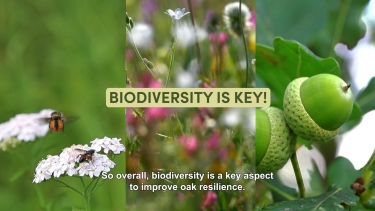How can we encourage sustainable investments in forest biodiversity?

A new science-policy study from EFI sets out how forest-related biodiversity could be included in the EU Taxonomy, to help encourage sustainable investments in forests.
The EU Taxonomy Regulation creates a common set of indicators and criteria to classify sustainable commercial activities and investments. While forest-related activities have been included in the EU Taxonomy under climate change mitigation and adaptation criteria, so far they have been excluded from biodiversity protection and restoration criteria.
This report aims to fill the gap. Based on scientific evidence it provides guidance for biodiversity-oriented forest management, and proposes a set of 26 quantitative indicators and provides examples of thresholds which would be applicable under the EU Taxonomy standard. Novel monitoring methods are presented for cost efficient assessments of forest biodiversity and compliance to the Taxonomy.
Lead author Prof Gert-Jan Nabuurs, from Wageningen University and Research said: “There is sufficient scientific basis to state which forest management measures are beneficial for biodiversity and which not. We found it possible to set indicators and thresholds for biodiversity friendly forest management, but flexibility will be needed as investments will still need to provide a financial return. We realise flexibility is challenging in a Regulation.“
He added: “We found a good balance between biodiversity gains and rates of return. Some loss of return can possibly be compensated for with carbon credits, while overburdening investors and forest managers with bureaucracy needs to be avoided. In this way we can incentivise much needed investments in European forests."
Stefanie Linser, from the University of Natural Resources and Life Sciences, Vienna said: “We need to remember that a one-size-fits all approach does not work for complex forest ecosystems and diverse sustainable management options. We recommend taking a biogeographical-specific approach, and therefore in this study propose ranges for our biodiversity indicators and thresholds.”
Sophus zu Ermgassen from the University of Oxford said: “the EU taxonomy is one step towards incentivising investments in high ecological value forest management, but its reporting obligations are only one step in the piece of the overall biodiversity finance puzzle.”
Anna Begemann from the European Forest Institute said: "Including forest biodiversity criteria in the EU taxonomy would be crucial for sustainable finance to incentivise investment in nature. Much more needs to be done to redirect financial flows away from funding damaging activities such as deforestation and forest degradation and towards protecting forest biodiversity".
Davide Pettenella from the University of Padova said: "The availability of a forest Taxonomy meets the demand of an increasing number of investors in the forestry sector seeking investment opportunities that ensure compliance with rigorous and shared biodiversity conservation standards."
More information
Nabuurs, G.J., Begemann, A., Linser, S., Paillet, Y., Pettenella, D., zu Ermgassen, S. 2024. Sustainable finance and forest biodiversity criteria. From Science to Policy 16. European Forest Institute.
https://doi.org/10.36333/fs16


